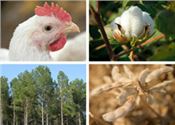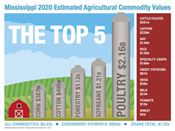|
Despite Challenges, 2020 Ag Increased In Value In State

Poultry remains Mississippi’s top ag commodity in a year that saw agriculture reach an estimated value of production of $7.35 billion.
Soybeans, forestry and cotton round out the top four by order of production value.
Photo illustration by MSU Extension Service/Kevin Hudson
STARKVILLE, MISS.
Mississippi farmers generated an estimated agricultural value of $7.35 billion in 2020, a 5 percent increase from 2019 saw soybeans top forestry for the No. 2 spot behind poultry.
The predicted total ag value exceeds 2019’s production value of $7.01 billion, marking the ninth consecutive year that agriculture topped $7 billion in the state.
Keith Coble, head of the Mississippi State University Department of Agricultural Economics, said the year did not start out looking good.
“We did some midyear analysis on June 1, and the economic picture for farm products looked pretty bleak,” Coble said. “We went through unprecedented losses early to midyear, but markets have generally improved in the latter portion of the year.”
Josh Maples, an agricultural economist with the MSU Extension Service, said poultry took a hit from COVID-19-related issues and dropped 16 percent in value. But row crops were strong, posting a combined $2.6 billion estimated value.
“This was a turbulent year for all agricultural producers due to the market upheaval caused by the pandemic,” Maples said.
Poultry has an estimated 2020 value of $2.16 billion. Broilers suffered from spring inventory disruptions and lower prices, but eggs were a brighter spot, up 21 percent in estimated value.
“Eggs faced significant production challenges during the COVID-19 shutdowns while also experiencing a sharp demand increase due to grocery store demand,” Maples said. “Sharply higher prices were the result of supply challenges at the same time as a demand increase.”
Although rebounding markets and prices helped the year end stronger than expected for some commodities, higher than normal government payments of an estimated $930 million helped make up some of the gap caused by early market devastation. Coronavirus Food Assistance Programs made up a significant portion of the 2020 government payments.
Forestry holds the No. 2 ag spot most years, but COVID-19 caused many sawmills to scale back production or temporarily close. When mills were not in operation, timber was not being cut and sold, so forestry declined an estimated 2.6 percent to an overall value of $1.12 billion.
That decline opened the door for soybeans to surge into second place with an estimated production value of $1.21 billion. The crop’s value grew an estimated 67 percent over 2019 based mostly on an improved soybean market. Soybeans also reclaimed acreage lost the previous year.
Cotton comes in at No. 4 for agriculture with an estimated value of $491 million. Low prices at planting caused by COVID-19 disruptions decreased cotton acreage, but prices rebounded by harvest.
Following are other estimated ag values and their change from 2019: corn, down 10 percent to $387 million; rice, up 44 percent to $138 million; peanuts, up 34 percent to $19 million; cattle and calves, up 5 percent to $261 million; catfish and specialty crops stayed unchanged at $226 million and $106 million, respectively; sweet potatoes, up 2 percent to $96.7 million; and hay, up 3 percent to $140 million. ∆

|
|